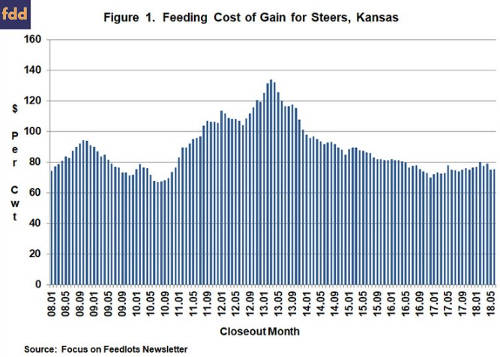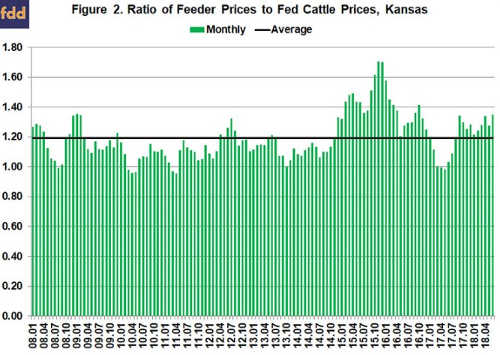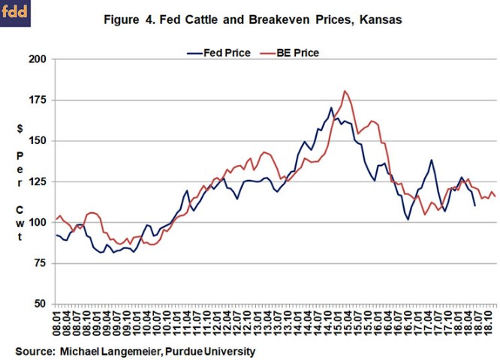By Michael Langemeier
Center for Commercial Agriculture
Purdue University
After large losses in 2015 and 2016, cattle finishing net returns averaged approximately $110 per head in 2017. Net returns were much tighter in the first half of 2018. Current prospects for the second half of 2018 are not much brighter. In addition to discussing net return prospects for cattle finishing in the second half of 2018, this article discusses trends in feeding cost of gain and the feeder to fed price ratio, key factors influencing changes in net returns.
Several data sources were used to compute net returns. Average daily gain, feed conversion, days on feed, in weight, out weight, and feeding cost of gain were obtained from monthly issues of the Focus on Feedlots newsletter. Futures prices for corn and seasonal feed conversion rates were used to project feeding cost of gain for the next several months. Net returns were computed using feeding cost of gain from monthly issues of the Focus on Feedlots newsletter, fed cattle prices and feeder cattle prices reported by the Livestock Marketing Information Center (LMIC),and interest rates from the Federal Reserve Bank of Kansas City.
Figure 1 illustrates monthly feeding cost of gain from January 2008 to June 2018. Feeding cost of gain averaged $77.20 per cwt. in 2016 and $74.34 per cwt. in 2017. Since the start of 2018, feeding cost of gain has ranged from $74.85 in May to $79.75 per cwt. in February. Given current corn and alfalfa price projections, feeding cost of gain is expected to range from $70 to $75 for the rest of 2018. Feeding cost of gain is sensitive to changes in feed conversions, corn prices, and alfalfa prices. Regression analysis was used to examine the relationship between feeding cost of gain, and feed conversion, corn prices, and alfalfa prices. Results are as follows: each 0.10 increase in feed conversion increases feeding cost of gain by $1.32 per cwt., each $0.10 per bushel increase in corn prices increases feeding cost of gain by $1.06 per cwt., and each $5 per ton increase in alfalfa prices increases feeding cost of gain by $0.52 per cwt.

The ratio of feeder to fed cattle prices for the last ten years is illustrated in figure 2. During the ten-year period, this ratio averaged 1.19. The feeder to fed price ratio was one standard deviation below (above) this average for 14 (19) months during the ten-year period. The average net return for the months in which the ratio was below one standard deviation of the average was $146 per head. In contrast, the average loss for the months in which the ratio was above one standard deviation was $243 per head. Of the 19 months with a ratio above one standard deviation of the average feeder to fed price ratio, 18 of these months, including June 2018, have occurred since January 2015. Given current price projections, the feeder to fed price ratio is expected to remain above 1.25 through September and above the ten-year average through the rest of this year. These relatively high ratios are likely to result in cattle finishing losses for the second half of 2018. Of course, an unexpected increase in fed cattle prices, would create a downward spike in this price ratio and would improve the outlook for net returns.

Monthly steer finishing net returns from January 2007 to June 2018 are presented in Figure 3. It is important to note that net returns were computed using closeout months rather than placement months. Net returns averaged approximately $110 per head in 2017. During the first quarter of 2018, net returns ranged from $8 per head in March to $51 per head in January. Average losses in the second quarter of 2018 ranged from $40 in May to $145 in June. Historical and breakeven prices for the last ten years, as well as projected breakeven prices for the rest of 2018 and the first quarter of 2019, are illustrated in figure 4. Breakeven prices for the rest of 2018 are expected to range from $115 to $120 per cwt., with the higher breakeven prices occurring in the third quarter. Current fed cattle price projections suggest that the breakeven prices indicated above will result in cattle finishing losses of approximately $95 per head in the third quarter and approximately $40 per head in the fourth quarter. Prospects for the first quarter of 2019 are brighter. If current projections play out, cattle finishing returns will be positive in early 2019.


This article discussed recent trends in feeding cost of gain, the feeder to fed price ratio, and cattle finishing net returns. Current breakeven and fed cattle price projections suggest that losses will continue for the rest of 2018. Prospects for early 2019 are considerably brighter. Given the recent stability in feeding cost of gain, net return projections for the next few months are primarily driven by the feeder to fed price ratio. For losses to diminish in the last half of 2018, we would need fed cattle prices in the $115 to $120 per cwt. range.
Source: farmdocdaily